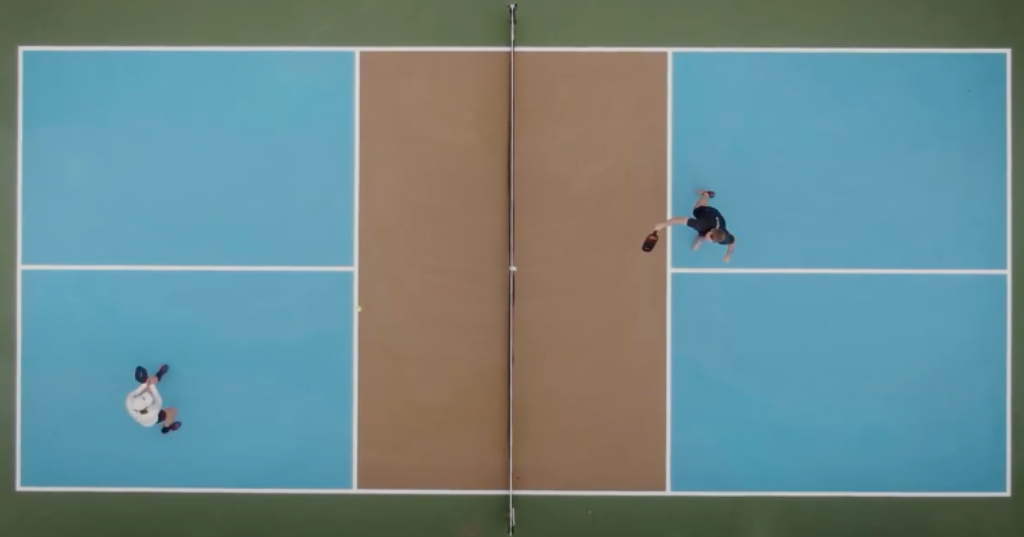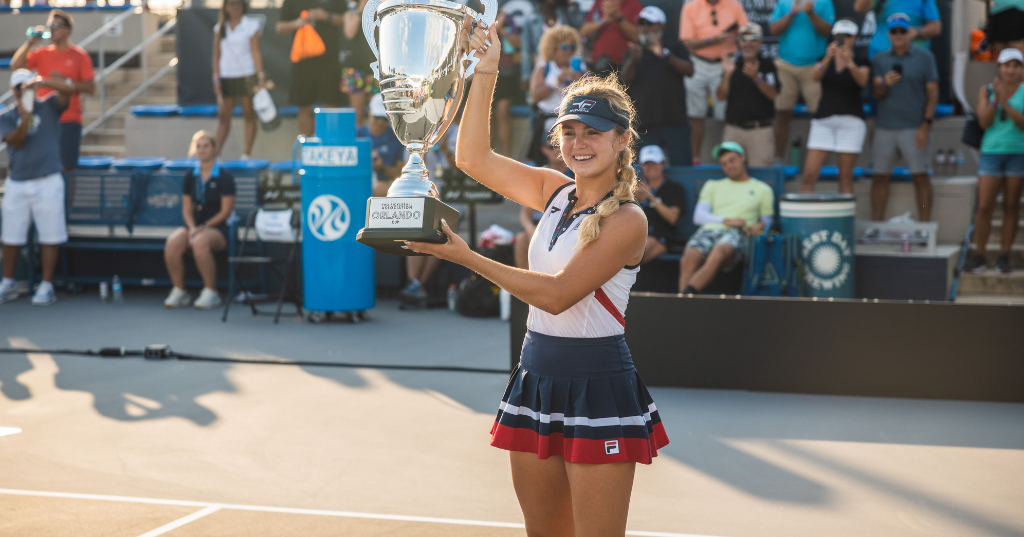Millions of Americans have caught pickleball fever of late, and quite a few of them are building makeshift courts in their cul-de-sacs and driveways as a result. For those creating courts at home or looking to familiarize themselves with pickleball courts, let this article be your guide.
Pickleball courts measure 20’ wide by 44’ long (including lines). The USA Pickleball Rulebook recommends having an area at least 30’ wide and 60’ long in total space for safe play. Like tennis, courts are typically made with either concrete or asphalt. However, clay and grass surfaces are trending.
Because of the explosive demand for pickleball in the United States, the infrastructure of proper courts hasn't been able to keep up. This means more people are playing on improvised surfaces than ever before. This article will walk through all facets of the ideal pickleball court.
What Should a Standard Pickleball Court Look Like?
A standard pickleball court is divided into two equal parts by its net, which runs the entire 20' width of the court and splits the 44' length of the court into 22' halves. The net is 36" tall at the posts, sagging to 34" in the absolute center of the court.
USA Pickleball’s Equipment Standards Manual defines a standard cour in section 2 of the document, including court dimensions and line details.
All lines should be 2" wide and included in the court’s total dimensional area. The lines should also be in high contrast to the color of the court; which is why the majority of court lines are white, as they provide stark visual contrast to the dark green of most court surfaces.
Parts of the Pickleball Court
Learning pickleball, or at least becoming great at pickleball, requires a high level of understanding of the court’s different zones. All areas of a pickleball court have unique names.
Many beginners look at a pickleball court and see similarities to tennis. If that's you, you'll notice some names and terms are shared across both sports, but you'll also find several terms novel to pickleball.
Let's break down the parts of a pickleball court into two groups: lines and areas.
Lines of a Pickleball Court
- Baseline: This is the back line of each half of the court. It runs parallel to the net and marks the two ends of the court’s 44' length. The baseline is also where the ball is served from and creates a plane that the serving player can't cross during their serve.
- Sidelines: Running perpendicular to the net and extending the length of the court, a sideline marks the boundaries of the 20’ outer width of a court and is located on both sides of the court.
- Centerline: Perpendicular to the net, the centerline runs 15' from baseline to the non-volley line on both halves of the court. It separates the odd and even courts.
- Non-Volley Line: The non-volley line runs parallel to the net and is found 7' from the net on both halves of the court. It marks the kitchen/non-volley zone's outer boundary closest to the baseline.
Areas of a Pickleball Court
- Non-Volley Zone: This zone, more commonly referred to as the kitchen, covers the width of the court and the first 7' from the net on both sides of the court. It's bounded by the non-volley line and the sidelines. Naturally, no volleys are permitted in this area, and serves cannot bounce in or touch the non-volley zone's lines.
- Odd and Even Courts: Also called right and left service area, these are the two boxes in the back of each court that are created by the baseline, centerline, sideline, and non-volley line. The even court is the diagonal box on the right side of the centerline, if you’re facing the net. The odd court is the box to the left of the centerline when facing the net. The name identifies server position in doubles as stated in the score.
What Is the Best Court Surface for Pickleball?
Asphalt and cement are often considered the best surfaces for pickleball. However, this may be largely influenced by tennis and pickleball's wide adoption of tennis courts. An emerging pickleball court trend is seeing other surfaces, like grass and clay, gaining popularity.
Tennis courts are an easy default for pickleball, and it's a big reason why so many tennis courts are converting to pickleball. It's easy enough to tape off or draw lines for pickleball on top of tennis courts, making those spaces work for both sports.
But just because it's easy doesn't necessarily mean that tennis courts are the best courts for pickleball.
This has given rise to pickleball-specific courts popping up, helping push the sport beyond the confines and reputation of tennis. While cement and asphalt create a better bounce for players, pickleball lovers have recently been branching away from the traditional surfaces.
Two Emerging Outdoor Pickleball Court Surfaces
Technically speaking, you can play pickleball on grass or clay. And we find more athletes doing this because it adds variety to the game. After all, these materials create a more unpredictable bounce.
- Clay Pickleball Courts: Usually found in the form of Har-Tru or red clay, clay courts are gaining a lot of attention in pickleball, especially Har-Tru in the United States. Har-Tru is a greenish-grayish color, and it offers a more predictable bounce and a faster pace than the traditional red clay often found in Europe and South America.
- Grass Pickleball Courts: Grass is an interesting option because it deadens the bounce, making the kitchen even more challenging. This surface enables players to use strategies that don’t usually work on traditional cement or asphalt.
Indoor Pickleball Court Surfaces
Indoor pickleball can allow players to interact with different surfaces that wouldn’t do as well in an outdoor environment. Typically this is a concrete or asphalt base with a layer of acrylic on top for a bit of cushioning for each bounce.
With a mix of different surfaces and sometimes a makeshift court, you might wonder what standards set a great pickleball court apart from a subpar one.
What Makes a Good Pickleball Court?
A good pickleball court has the right dimensions, reliable surface materials, and permanently affixed netting. While makeshift courts are great for accessibility, a permanent structure ensures that the game's rules are followed and the game is played in its intended way.
Aside from the dimensions and court surfaces, a high-quality net makes a tremendous difference in gameplay, while a couple of other nice-to-have elements add luxury to the equation but aren't critical to playing correctly.
Let's have a closer look at all three components:
1. Pickleball Net
There are a variety of nets on the market, ranging from basic plastic nets to high-end mesh nets. Here are the must-haves:
- Any mesh material that allows for visibility on the other side while also not letting the ball pass through the holes. A net similar to a tennis net is ideal.
- From post to post, it should be 21’ and 9” long. From top to bottom, it should be 30’ wide. The posts on either end will be spaced 22’ apart, and their thickness should be no more than 3” in diameter.
- A permanent net is ideal.
2. Lighting
If you’re playing outdoors, natural light is always best. In warmer climates, you might use outdoor lights to continue to play after dusk. If you play indoor pickleball, it’s a good idea to use fluorescent lights instead of the LED or HID lights that may be set up outside.
3. Rest Area
Pickleball is hard work. If the area is big enough, there should be dedicated rest areas with benches and umbrellas to shade players taking a break. This is also where you can keep equipment, water, and any other materials you may need.
How Often Should a Pickleball Court Be Resurfaced?
Concrete and asphalt pickleball courts should be resurfaced once every five years. Pickleball courts are a small area. So, if played on frequently, a court may need resurfacing more often. Typically, resurfacing should happen during the spring and summer.
This is because outdoor pickleball courts have to be resurfaced in warmer temperatures and indoor courts should be resurfaced when at up to 60 degrees Fahrenheit.
Clay courts and grass courts need to be maintained differently than a standard court. They both require maintenance during warmer seasons.
Practice Makes Perfect
The more you play on different courts, the easier it will be to recognize a pickleball court's standard measurements and surface. USA Pickleball recommends having an area at least 30’ wide and 60’ (Section 2.A.3.) long to ensure there’s enough space around the court to move safely.
As you play, you may experience different surfaces other than cement or asphalt. Grass and clay may change your strategy, but all are options to incorporate.
But with people playing in cul-de-sacs and driveways, it shows that just about any hard surface can be fun to play America's fastest-growing sport on.




Leave a comment
This site is protected by hCaptcha and the hCaptcha Privacy Policy and Terms of Service apply.